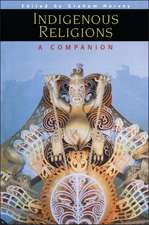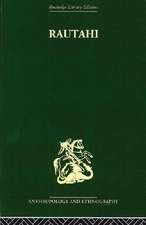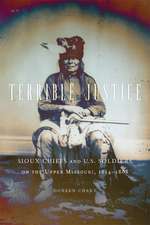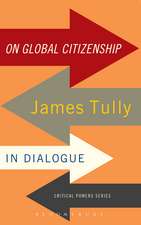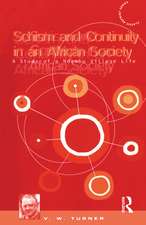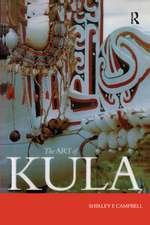A New Maori Migration: Rural and Urban Relations in Northern New Zealand: LSE Monographs on Social Anthropology
Autor Joan Metgeen Limba Engleză Hardback – 1964
| Toate formatele și edițiile | Preț | Express |
|---|---|---|
| Paperback (1) | 258.59 lei 6-8 săpt. | |
| Taylor & Francis – 29 apr 2022 | 258.59 lei 6-8 săpt. | |
| Hardback (1) | 792.71 lei 6-8 săpt. | |
| Taylor & Francis – 1964 | 792.71 lei 6-8 săpt. |
Din seria LSE Monographs on Social Anthropology
-
 Preț: 310.01 lei
Preț: 310.01 lei -
 Preț: 104.90 lei
Preț: 104.90 lei -
 Preț: 230.87 lei
Preț: 230.87 lei -
 Preț: 391.40 lei
Preț: 391.40 lei - 18%
 Preț: 703.93 lei
Preț: 703.93 lei - 16%
 Preț: 234.90 lei
Preț: 234.90 lei - 17%
 Preț: 190.88 lei
Preț: 190.88 lei -
 Preț: 380.03 lei
Preț: 380.03 lei -
 Preț: 385.80 lei
Preț: 385.80 lei -
 Preț: 345.71 lei
Preț: 345.71 lei - 18%
 Preț: 706.28 lei
Preț: 706.28 lei - 25%
 Preț: 766.73 lei
Preț: 766.73 lei -
 Preț: 382.36 lei
Preț: 382.36 lei - 18%
 Preț: 946.12 lei
Preț: 946.12 lei -
 Preț: 388.68 lei
Preț: 388.68 lei -
 Preț: 386.46 lei
Preț: 386.46 lei -
 Preț: 387.75 lei
Preț: 387.75 lei - 15%
 Preț: 644.88 lei
Preț: 644.88 lei -
 Preț: 347.80 lei
Preț: 347.80 lei -
 Preț: 348.83 lei
Preț: 348.83 lei - 16%
 Preț: 234.90 lei
Preț: 234.90 lei - 18%
 Preț: 788.25 lei
Preț: 788.25 lei - 18%
 Preț: 208.91 lei
Preț: 208.91 lei - 17%
 Preț: 214.75 lei
Preț: 214.75 lei - 18%
 Preț: 943.62 lei
Preț: 943.62 lei - 25%
 Preț: 600.01 lei
Preț: 600.01 lei -
 Preț: 340.17 lei
Preț: 340.17 lei -
 Preț: 382.54 lei
Preț: 382.54 lei -
 Preț: 387.91 lei
Preț: 387.91 lei -
 Preț: 390.41 lei
Preț: 390.41 lei -
 Preț: 349.80 lei
Preț: 349.80 lei -
 Preț: 389.66 lei
Preț: 389.66 lei -
 Preț: 284.78 lei
Preț: 284.78 lei -
 Preț: 388.30 lei
Preț: 388.30 lei -
 Preț: 394.87 lei
Preț: 394.87 lei -
 Preț: 346.66 lei
Preț: 346.66 lei -
 Preț: 353.40 lei
Preț: 353.40 lei -
 Preț: 350.48 lei
Preț: 350.48 lei - 18%
 Preț: 794.51 lei
Preț: 794.51 lei -
 Preț: 387.60 lei
Preț: 387.60 lei
Preț: 792.71 lei
Preț vechi: 966.71 lei
-18% Nou
Puncte Express: 1189
Preț estimativ în valută:
151.72€ • 156.36$ • 128.09£
151.72€ • 156.36$ • 128.09£
Carte tipărită la comandă
Livrare economică 01-15 martie
Preluare comenzi: 021 569.72.76
Specificații
ISBN-13: 9781859738993
ISBN-10: 1859738990
Pagini: 324
Dimensiuni: 138 x 216 x 22 mm
Greutate: 0.75 kg
Ediția:1
Editura: Taylor & Francis
Colecția Routledge
Seria LSE Monographs on Social Anthropology
Locul publicării:Oxford, United Kingdom
ISBN-10: 1859738990
Pagini: 324
Dimensiuni: 138 x 216 x 22 mm
Greutate: 0.75 kg
Ediția:1
Editura: Taylor & Francis
Colecția Routledge
Seria LSE Monographs on Social Anthropology
Locul publicării:Oxford, United Kingdom
Cuprins
Contents 1. MAORI URBANISATION: THE PROBLEM AND ITS BACKGROUND I I. The Country 2. THE PEOPLE AND THE LAND 23 3. KINSHIP AND DESCENT 46 4. COMMUNITY DIVISIONS, LEADERSHIP AND SOLIDARITY 78 5. MIGRATION 96 II. The City 6. THE DEMOGRAPHIC BACKGROUND 1117. THE LOCAL PEOPLE 118 8. IMMIGRANTS AND CITY-BORN 122 9. HOUSING AND DOMESTIC ORGANISATION 141 10. KINSHIP AND DESCENT 15411. MARRIAGE PATTERNS AND CEREMONIAL 182 12. VOLUNTARY ASSOCIATION 194 13. LEADERSHIP, SOCIAL CONTROL AND COMMUNITY SOLIDARITY 211 III. City and Country 14. URBAN-RURAL RELATIONS 231 15. STABILITY AND CHANGE IN MAORI SOCIETY 251 TABLES 267 GLOSSARY 287 BIBLIOGRAPHY 290 INDEX 293
Descriere
Until 1939 the Maori people remained an almost wholly rural community, but during and after the second world war increasing numbers of them migrated in search of work to the cities, and urban groups of Maori were established.




